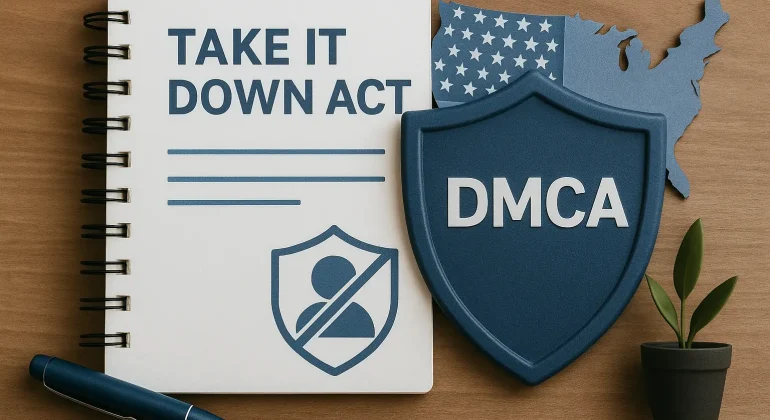Sommaire
Introduction
In a constantly evolving digital environment, the protection of intellectual property and the safeguarding of individual rights online have become essential. In the United States, the fight against copyright infringement has relied for more than twenty years on the Digital Millennium Copyright Act (DMCA). However, with the rise of new threats, particularly linked to deepfakes and the non-consensual dissemination of intimate images, a new piece of legislation has emerged: the Take It Down Act.
This article examines the scope, functioning, and impact of this law, comparing it with the DMCA to better understand their complementarity.
What is the take it down act?
The take it down act is a recent US legislative initiative designed to allow the removal of intimate images of minors and non-consensual sexual content, including those artificially generated through deepfakes.
Unlike traditional copyright-centered legislation, this Act aims to directly protect victims of image-based abuse. Online platforms are now required to establish accessible, fast, and effective takedown procedures.
This mechanism reflects a strong societal priority: safeguarding the dignity and privacy of individuals in an age of algorithmic manipulation.
The DMCA: origins, objectives, and scope
Why was the DMCA adopted?
Enacted in 1998, the Digital Millennium Copyright Act is the cornerstone of online copyright enforcement in the United States. It was designed to align US law with the WIPO Internet treaties and to adapt legislation to the growing use of the Internet.
Its primary purpose is to combat large-scale piracy, while establishing a safe harbor regime for online service providers that comply with takedown requests.
How does it work in practice?
The DMCA allows rights holders to:
- Send a takedown notice to hosting providers and platforms;
- Obtain the prompt removal of infringing content without prior court intervention;
- Benefit from deterrent sanctions against persistent infringers.
Nevertheless, it has been criticized for its abuses, with some parties misusing it to censor legitimate content.
How does take It down Act differ from the DMCA?
A targeted response to deepfakes and intimate images
Whereas the DMCA applies to copyright-protected works, the Take It Down Act addresses personal and intimate content over which victims may not hold intellectual property rights. It therefore fills a significant legal gap.
The obligations under the Act include:
- Implementing verification procedures for requests made by minors or adults;
- Complying with short response deadlines for removals;
- Ensuring greater transparency in complaint mechanisms.
New obligations for platforms
Social networks, hosting providers, and specialized websites are subject to:
- Reinforced compliance standards;
- Increased liability in the event of inaction;
- Financial and reputational risks in case of non-compliance.
This evolution marks a major shift in responsibility towards digital intermediaries.
Strategic consequences for rights holders and businesses
Risks, compliance, and reputation management
For companies, particularly in the technology, cultural, and luxury sectors, both the DMCA and Take It Down Act raise significant challenges:
- Enhanced monitoring of platforms to detect unauthorized use;
- Anticipation of identity and image-related infringements;
- International cooperation to address the cross-border nature of online violations.
The role of specialized legal counsel
A specialized law firm can provide:
- Monitoring and detection services to identify online infringements;
- Drafting and transmission of notices in line with applicable frameworks;
- Strategic advice to mitigate risks and protect brand reputation.
Such support enables businesses to strengthen their digital resilience and secure their intangible assets.
Conclusion
The take it down act does not replace the DMCA, but rather serves as a necessary complement. While the DMCA remains central in the fight against copyright infringement, The take it down Act provides a legal response adapted to abuses linked to intimate images and deepfakes.
Companies must now consider a comprehensive compliance strategy, combining intellectual property protection with the defense of personal rights.
Dreyfus Law firm assists its clients in managing complex intellectual property cases, offering personalized advice and comprehensive operational support for the complete protection of intellectual property.
Dreyfus Law firm is partnered with a global network of lawyers specializing in intellectual property.
Nathalie Dreyfus with the assistance of the entire Dreyfus team.
FAQ
1. What is the take it down act?
A US law requiring the removal of non-consensual personal images, including AI-generated content.
2. How does the take it down act differ from the DMCA?
The DMCA protects copyright, while Take It Down Act addresses abuse of personal and private images.
3. Are online platforms legally required to comply?
Yes, they must implement effective mechanisms or face sanctions.
4. Can the take it down act be used to protect trademarks?
No. Trademarks and copyright issues fall under the DMCA and traditional IP enforcement.
5. Is the DMCA still relevant?
Yes, it remains the primary tool for combating online copyright infringement.


